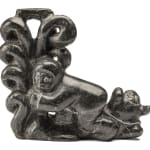DAVIDIALUK ALASUA AMITTU (1910-1976) PUVIRNITUQ (POVUNGNITUK)
signed, “ᑎᕕᑎ ᐊᒥᑐ”.
Further images
Davidialuk is an artist who has been justly celebrated for his obsession in depicting dramatic scenes from stories and legends in his sculptures and prints. In his "Foreword" to the commemorative publication Davidialuk 1977, Ian Lindsay referred to Davidialuk as "…one of the last myth-makers" [1]. The artist carved several depictions of this story; here is a quick summary of the details:
One night, three companions went outside and one of them started whistling. The Northern Lights began to roar and whip up a violent wind, but ignoring the warnings of his friends, the young man kept whistling. The Aurora swooped down, decapitated him, and played football with his head. Since then, no one whistles outdoors at night [2].
* "Davidialuk has inscribed an unrelated legend in syllabics on the bottom of the carving, probably because, working on several pieces at the same time, he got them mixed up. Mr. Murdoch, who received the carving from the artist himself, was told that it did indeed describe the Northern Lights Legend." [Stories in Stone, p. 34] For the curious, the inscription reads: "ᐅᓂ ᑲᑐᐊ ᑲᐅᔭᔪ ᐃᓕᐊᕈ ᑐᔪᓕ ᓯᓂ ᐸᑐ / ᓄᓚ ᔪᕕᓂ ᐃᓚᒥ ᓯᑯᑎᕆᑲᑐ". (A story about Kautjajuk who was an orphan and slept on the porch and lying down in the house.)
1. Marybelle Myers ed., Davidialuk 1977 (La Fédération des Coopératives du Nouveau-Québec, 1977), unpaginated.
2. Ingo Hessel, Inuit Art: An Introduction (1998), p. 83.
References: For other examples of the "Northern Lights" theme by Davidialuk see Ingo Hessel, Inuit Art: An Introduction (1998), fig. 61. For more detailed information on Inuit beliefs regarding the Aurora Borealis (known as Aqsarniit in Inuktitut) see John MacDonald, The Arctic Sky: Inuit Astronomy, Star Lore, and Legend (Toronto: Royal Ontario Museum, 1998), 146-157.
The artist has impressively made elemental phenomena, such as the northern lights, composite in his works of mythical subject matter before. This present work depicts the story of Kaujajuk [2], an orphaned boy that was mistreated and made to sleep on the outside amongst the dogs. Kaujajuk would sing to the moon,
“Moon, up thereMy brotherlike, up there
You give me a little bit of warmth,
The window has become bright,
Moon up there, you are the only source of light,
I am trying to dry my clothes,
It is unlikely, it is hopeless, it will not.”
Hearing the boy’s song, the moon came down and made Kaujajuk big and strong so that he could seek vengeance on his tormentors.
In Davidialuk’s well-modeled scene the whole composition is brought together in what is believed to be the story’s dramatic climax, when the moon comes down to supernaturally aid the young boy. The scene is given a heightened sense of drama in an imaginative way solely through Davidaluk’s handling of the stone. The spindly tendrils of the artist’s moonlight sprout from the stone in a feverist tumble of corkscrews that test the tensile strength of his medium. Emotional qualities are intensified by the face and posture of the small boy. His mouth is depicted in a frozen gasp to convey his distress. His arms and head are flung back to suggest his shock, which in turn balances the forward lunge of his larger, transformed self toward the beams of the moonlight.
-1. Ian G. Lindsay, Marybelle Myers, ed., Davidialuk 1977, illustrated exh. cat., (S.L.: La Fédération des Coopératives du Nouveau-Québec, 1977), “Foreword Davidialuk of Povungnituk: Myth-Maker”, unpaginated.
2. Also Qaujugjut/Qaudjagdjuq/Kautahuk/Kavjagjuk/Kagsagsuk/Ahatoak
3. For additional information on the story of Kaujajuk, see Keeveeok, awake! : Mamnguqsualuk and the rebirth of legend at Baker Lake, exh. cat., (Alberta: Ring House Gallery, University of Alberta, 1986), p. 33-4
Provenance
Ex. Collection of Peter Murdoch, Montreal, purchased from the artist c. 1974;
By descent to the Estate of Lucille Drouin Murdoch.
Exhibitions
Thomas Owen Eisomon et al, Stories in Stone (FCNQ and Canadian Museum of Civilization, 1988) cat. 7.






